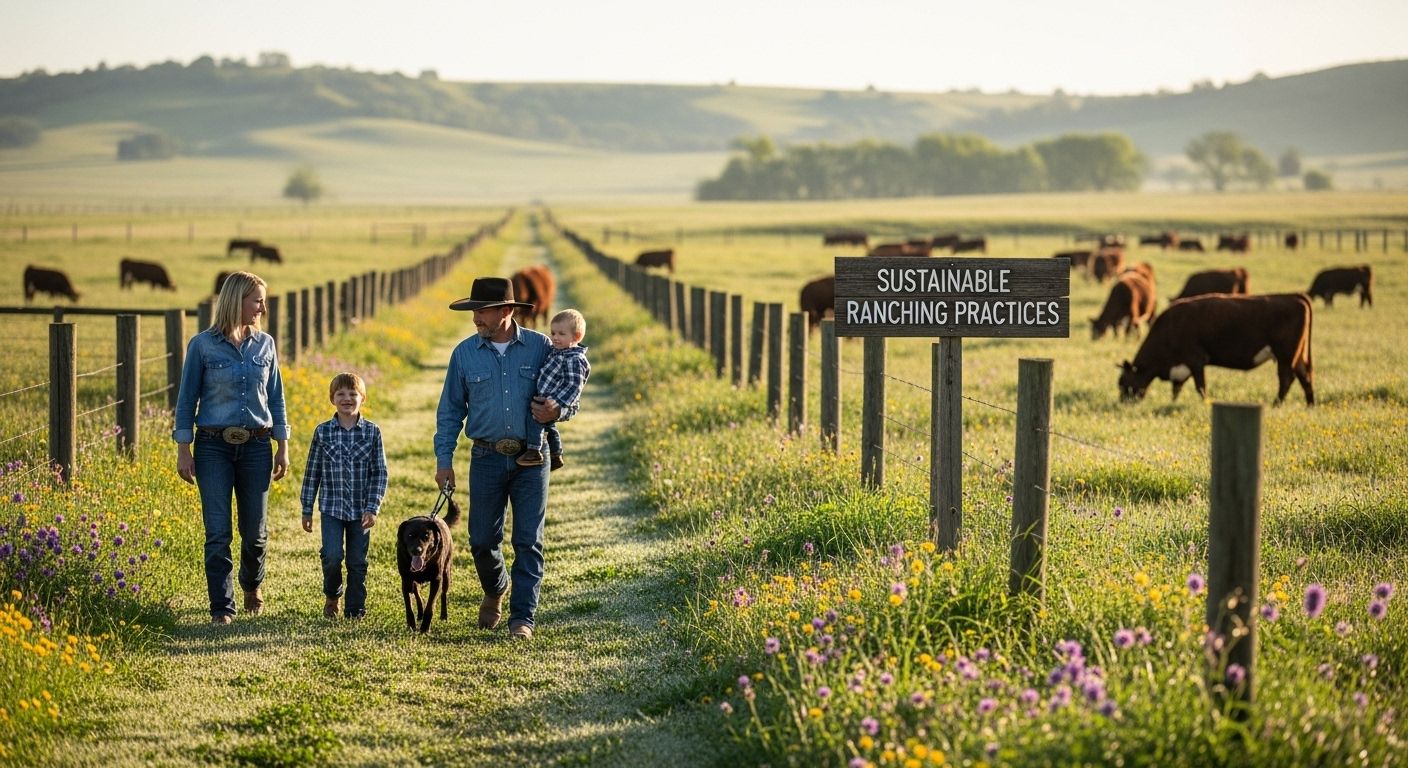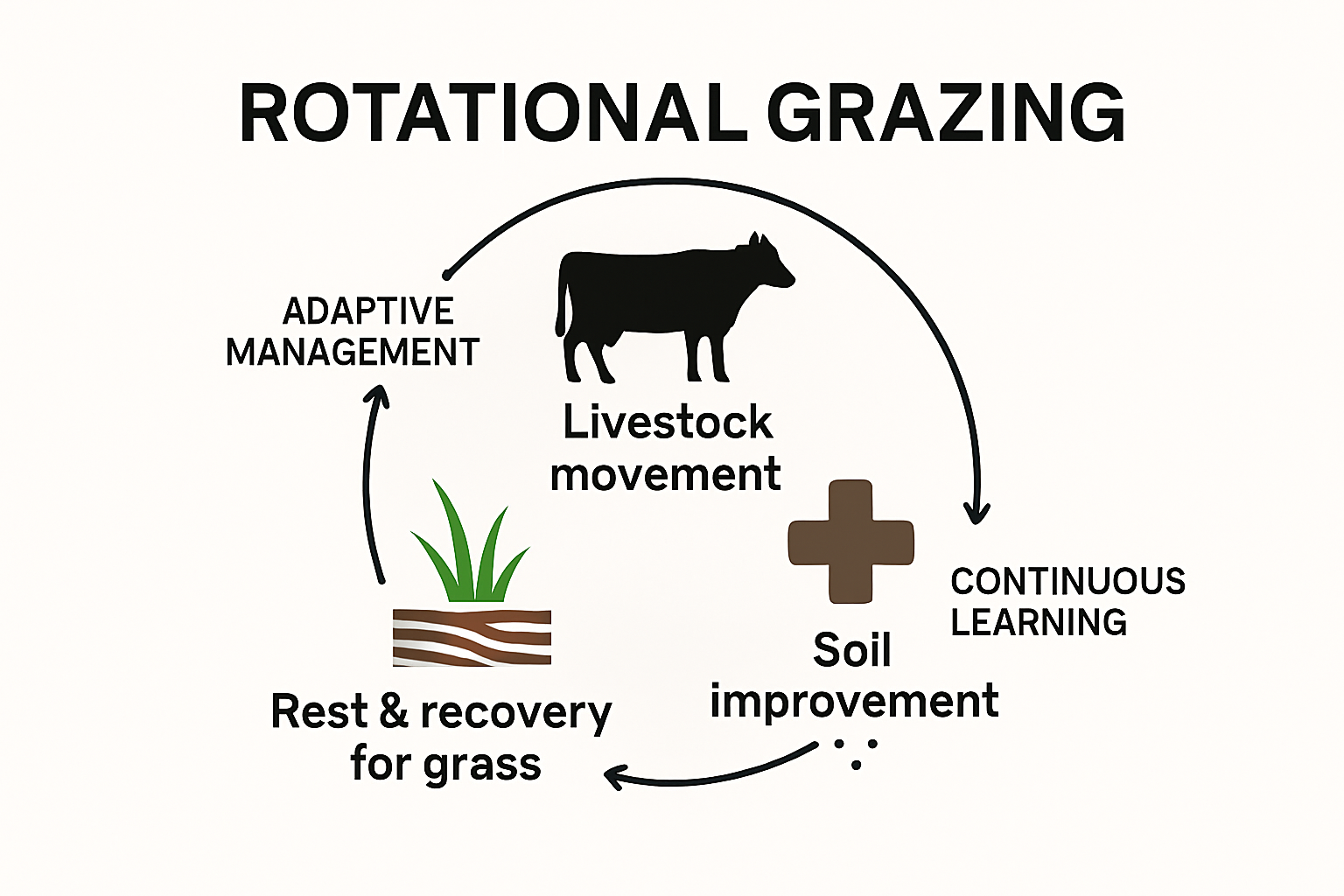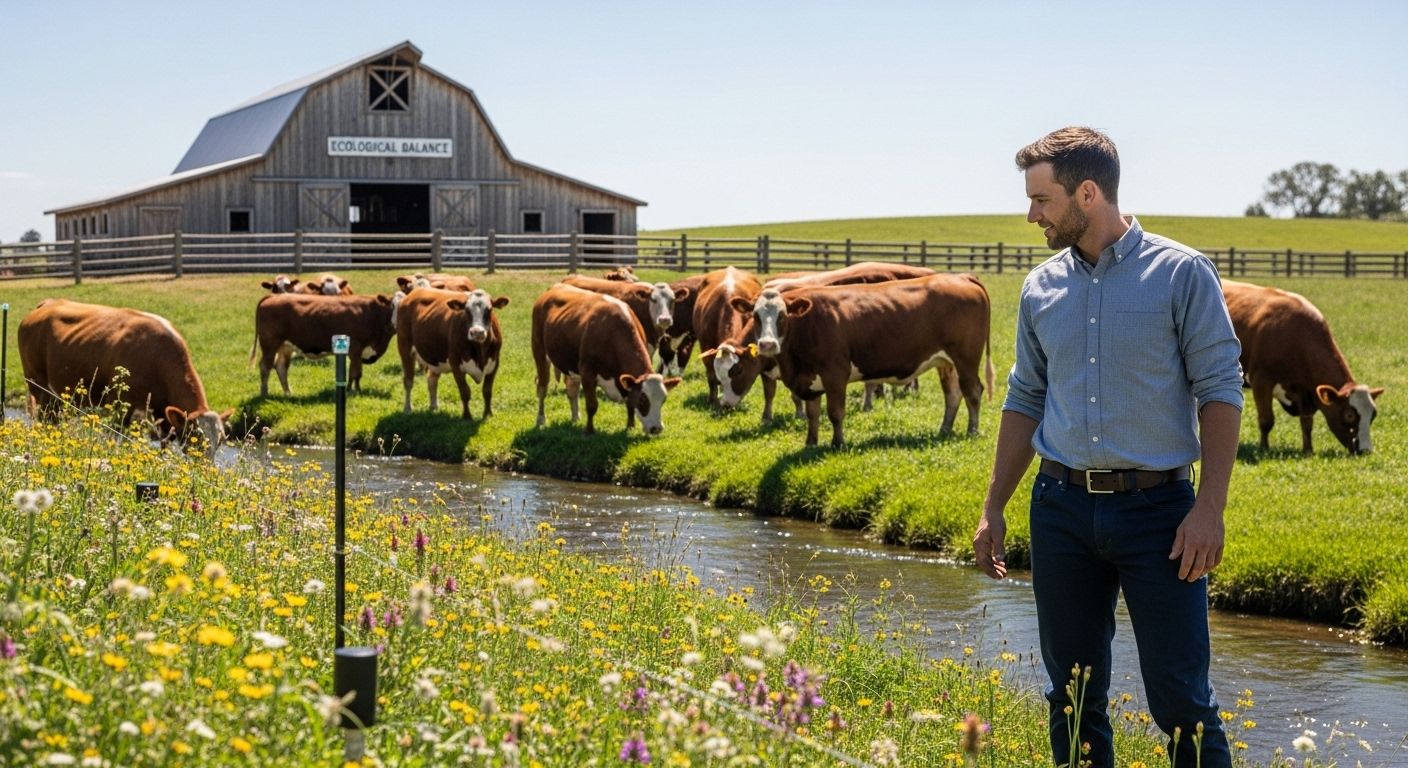Sustainable ranching is changing everything about how we produce beef and manage land. Think about this. Research shows sustainable ranching can improve land productivity by up to 40 percent while reducing harm to the environment. That sounds good for the planet but the surprising part is how these methods are actually making ranches more profitable and resilient than ever before.

Table of Contents
- What Are Sustainable Ranching Practices?
- Why Sustainable Ranching Matters For Our Environment
- How Sustainable Ranching Practices Support Animal Welfare
- Key Concepts Behind Sustainable Ranching Approaches
- Real-World Examples Of Successful Sustainable Ranching
Quick Summary
| Takeaway | Explanation |
|---|---|
| Implement rotational grazing for efficiency | Rotate livestock regularly to enhance grassland health and productivity. This practice promotes ecological balance and increases land resilience. |
| Minimize chemical use to conserve ecosystems | Reduce reliance on chemicals to maintain soil health and protect biodiversity. Sustainable methods preserve the integrity of natural habitats. |
| Enhance animal welfare through natural practices | Create spacious environments for livestock that allow for natural behaviors. Prioritizing welfare leads to healthier animals and more sustainable ranch operations. |
| Adopt adaptive management for continuous improvement | Regularly assess and adjust practices based on environmental feedback. This dynamic strategy helps maintain ecological integrity while optimizing farm productivity. |
| Focus on long-term ecological balance | Prioritize sustainable practices that support future environmental health and economic viability. A holistic approach benefits both ranchers and ecosystems. |
What are Sustainable Ranching Practices?
Sustainable ranching practices represent a holistic approach to livestock management that balances environmental preservation, animal welfare, and economic viability. These practices go far beyond traditional agricultural methods by integrating ecological principles with productive agricultural systems.
Defining Sustainable Ranching
Sustainable ranching is fundamentally about creating agricultural systems that maintain long term environmental health while supporting rancher livelihoods. According to National Sustainable Agriculture Coalition, these practices aim to minimize environmental impact, protect biodiversity, and ensure soil and water resource conservation.
Key characteristics of sustainable ranching include:
- Maintaining healthy grassland ecosystems
- Implementing rotational grazing techniques
- Minimizing chemical interventions
- Protecting wildlife habitats
- Reducing carbon footprint
Environmental and Economic Benefits
Ranchers adopting sustainable practices recognize that ecological stewardship directly connects to economic resilience. By protecting soil quality, managing water resources, and maintaining diverse grassland ecosystems, ranchers create more robust agricultural systems. World Wildlife Fund research demonstrates that sustainable ranching can improve land productivity by up to 40% while reducing environmental degradation.
Sustainable ranching is not just an environmental strategy but a comprehensive approach to agricultural management that considers interconnected ecological, economic, and social systems. This method ensures that agricultural production supports both current agricultural needs and future environmental sustainability.
To clarify the core differences between sustainable ranching and traditional ranching approaches, the following table compares their key features and impacts side by side.
| Aspect | Traditional Ranching | Sustainable Ranching |
|---|---|---|
| Grazing Methods | Continuous, often non-rotational | Rotational, strategic grazing |
| Chemical Use | Frequent use of fertilizers/pesticides | Minimized chemical interventions |
| Environmental Impact | Often leads to habitat degradation | Focuses on ecological preservation |
| Animal Welfare | Limited space, stress more common | Promotes natural behaviors and welfare |
| Economic Approach | Short-term gains prioritized | Long-term resilience and profitability |
| Carbon Footprint | Can be significant | Actively reduced through ecosystem strategies |
| Biodiversity | Limited protection for non-livestock species | Protects wildlife habitats and migration |
Why Sustainable Ranching Matters for Our Environment
Sustainable ranching represents a critical strategy for addressing environmental challenges while maintaining agricultural productivity. As global climate change and ecosystem degradation become increasingly pressing concerns, the role of responsible land management becomes paramount.
Ecosystem Protection and Biodiversity
Sustainable ranching practices directly contribute to preserving complex ecological systems. According to the US Forest Service, these practices help maintain essential ecosystem services that are fundamental to environmental health.
Key environmental benefits include:
- Protecting native grassland habitats
- Supporting wildlife migration corridors
- Preventing soil erosion
- Maintaining water quality in surrounding watersheds
- Reducing greenhouse gas emissions
Carbon Sequestration and Climate Mitigation
Grasslands managed through sustainable ranching techniques act as powerful carbon sinks. Healthy grazing lands can capture and store significant amounts of atmospheric carbon, effectively mitigating climate change impacts. Proper land management allows these ecosystems to absorb carbon dioxide more efficiently than many traditional agricultural approaches.
By implementing strategic grazing rotations, maintaining diverse plant species, and minimizing chemical interventions, ranchers create resilient landscapes that contribute to global carbon reduction efforts. These practices transform agricultural lands from potential carbon sources to critical carbon storage environments, offering a tangible solution to addressing climate challenges.
How Sustainable Ranching Practices Support Animal Welfare
Sustainable ranching practices represent a comprehensive approach to livestock management that prioritizes animal health, natural behaviors, and overall quality of life. By integrating ecological understanding with animal care principles, ranchers create environments that support both livestock well-being and ecosystem health.
Natural Habitat and Behavioral Opportunities
According to Oklahoma State University, animal welfare directly impacts the sustainability of agricultural systems. Sustainable ranching creates environments that allow livestock to express natural behaviors and maintain physical and psychological health.
Key welfare considerations include:
- Providing spacious grazing areas
- Enabling natural herd movement patterns
- Minimizing stress through thoughtful management
- Ensuring access to clean water and varied nutrition
- Supporting natural social interactions
Holistic Health Management
Sustainable ranching moves beyond traditional livestock management by implementing comprehensive health strategies. This approach reduces reliance on pharmaceutical interventions and focuses on preventative care through optimal living conditions. By maintaining diverse pasture ecosystems, ranchers create natural environments that support animal immune systems and reduce disease transmission risks.
Through strategic rotational grazing, careful population management, and ecosystem-based healthcare approaches, sustainable ranching practices establish a model of livestock management that respects both animal welfare and ecological balance. These methods ensure that animals live in conditions that closely mirror their natural habitats while maintaining agricultural productivity.
Key Concepts Behind Sustainable Ranching Approaches
Sustainable ranching is a sophisticated agricultural strategy that integrates ecological principles with productive land management. It represents a holistic approach that goes beyond traditional farming methods, focusing on creating resilient and regenerative agricultural systems.
Systems Thinking and Ecosystem Interconnectedness
According to Oklahoma State University Extension, sustainable ranching operates on the fundamental principle of understanding ecosystems as complex, interconnected networks. This approach recognizes that every agricultural action has cascading effects on environmental and biological systems.
Core principles of systems thinking include:
- Viewing the ranch as a living, dynamic ecosystem
- Understanding the interdependence of soil, plants, animals, and climate
- Recognizing that management decisions impact multiple system components
- Prioritizing long term ecological balance over short term productivity
- Embracing adaptive and responsive management strategies
Adaptive Management and Continuous Learning
Sustainable ranching is characterized by its dynamic and flexible approach. Ranchers continuously observe, analyze, and adjust their practices based on ecosystem responses. This method involves ongoing monitoring of land health, animal welfare, and environmental indicators.
By treating the ranch as a complex adaptive system, ranchers can develop more nuanced and responsive management techniques. This approach allows for real time adjustments that maintain ecological integrity while supporting agricultural productivity. The goal is not just to sustain current resources but to actively regenerate and improve ecosystem health through intentional, thoughtful management practices.

Real-World Examples of Successful Sustainable Ranching
Sustainable ranching is more than a theoretical concept. Across North America, innovative ranchers are demonstrating how ecological principles can be effectively implemented to transform agricultural landscapes and create economically viable farming systems.
Regenerative Transformation in Montana
According to the Natural Resources Conservation Service, the Brady family in Montana provides a compelling case study of sustainable ranching success. By strategically reseeding native grasses and implementing advanced water management techniques, they revitalized their ranch ecosystem.
Key outcomes of their sustainable approach included:
- Enhanced land productivity
- Increased wildlife habitat support
- Improved soil health
- Reduced erosion
- More resilient grassland ecosystems
Economic and Ecological Integration
Successful sustainable ranching demonstrates that environmental stewardship and economic productivity are not mutually exclusive. By adopting holistic management practices, ranchers can simultaneously improve ecological health and maintain profitable agricultural operations.
These innovative approaches involve complex strategies such as precise rotational grazing, diversified crop integration, and comprehensive ecosystem monitoring. Ranchers are essentially becoming ecological managers who view their land as a living, interconnected system rather than simply a production platform. Through careful observation, adaptive management, and a commitment to long term sustainability, these agricultural pioneers are redefining what modern ranching can achieve.
The table below summarizes specific benefits that sustainable ranching brings to three core areas: the environment, animal welfare, and ranch profitability. This helps illustrate the multi-dimensional value of sustainable practices discussed throughout the article.
| Benefit Area | Sustainable Ranching Impact |
|---|---|
| Environment | Protects native habitats, prevents soil erosion, maintains water quality, and stores carbon |
| Animal Welfare | Provides spacious grazing, supports natural behaviors, ensures low stress and better health |
| Economic Viability | Increases land productivity (up to 40%), reduces input costs, and enhances resilience |

Turn Sustainable Ranching Principles Into Real Results With FenceFast.ca
You are already exploring the path toward a healthier, profitable ranching future. This article highlights how sustainable ranching relies on eco-friendly management, animal health, and smart land use—yet making the shift often brings real challenges. These include finding reliable livestock solutions, securing versatile fencing, and managing animal welfare efficiently, especially as you adapt to rotational grazing and responsible ecosystem management.

Take the next step and bring these sustainable concepts to life on your operation today. FenceFast.ca makes it easy to source animal management supplies, advanced fencing systems, and monitoring tools designed for ranchers committed to long-term land health and productivity. Visit FenceFast.ca now to browse our comprehensive inventory and connect with expert advice so you can apply best practices from the article to your ranch. Do not wait—transform your sustainability goals into action that truly works.
Frequently Asked Questions
What are the main principles of sustainable ranching?
Sustainable ranching focuses on protecting soil quality, biodiversity, and water resources while integrating practices like rotational grazing, minimizing chemical use, and reducing carbon footprint.
How does sustainable ranching benefit the environment?
Sustainable ranching preserves ecosystems by protecting native habitats, preventing soil erosion, maintaining water quality, and acting as a carbon sink to mitigate climate change impacts.
What impact does sustainable ranching have on animal welfare?
Sustainable ranching prioritizes animal health by providing spacious grazing areas, allowing natural behaviors, and implementing holistic health management strategies that reduce stress and disease risks.
Can sustainable ranching be economically viable?
Yes, sustainable ranching can enhance land productivity and economic resilience by integrating environmental stewardship with profitable agricultural practices, leading to long-term sustainability for ranchers.
Recommended
-
[
Gallagher KIWITAH 3 X Grounding Kit for Large Energizer – FenceFast Ltd.
](https://fencefast.ca/products/gallagher-kiwitah-ground-stake-kit)
-
[
Lamb Packer – FenceFast Ltd.
-
[
Plastic Drum with Lid - 15 Gallon, Open Top, Blue – FenceFast Ltd.
](https://fencefast.ca/products/plastic-drum-with-lid-15-gallon-open-top-blue)
-
[
Gallagher MBS2800i Multi Power Fence Energizer 28 Joules – FenceFast Ltd.
](https://fencefast.ca/products/gallagher-fence-energizer-mb2800i)
